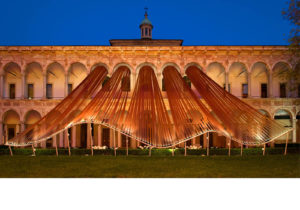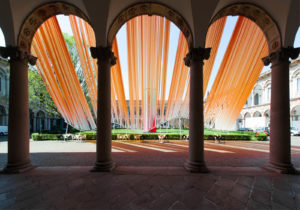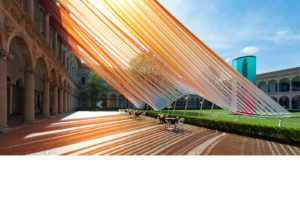
the city and the environment. Photos: MAD Architects.
Milan, Italy, takes its role seriously as an international center of design and fashion, so 2016 Milan Design Week featured mind-bending examples of modern architecture, interior design and product development. The Italian magazine Interni curated an exhibition for the event called “Open Borders,” and invited MAD Architects, a futuristic architecture studio located in Beijing, China, to contribute. The resulting installation, Invisible Border, creates a transitional space between the historical Cortile d’Onore loggias at the University Degli of Milan and an adjoining garden using only sculptured fabric.
Strips of ETFE in a graduated peach-to-salmon color spill from the building’s arched upper windows
to form a tensioned canopy over the courtyard below. The undulating shape of the canopy suggests natural wave-like motion, as do the fabric strips that flutter and make subtle whistling sounds when the wind blows. MAD Architects’ trademark designs blend nature and future, and Invisible Border establishes a shelter that is permeated by air, light and sound. “Our installation blurs the boundaries between the traditional and the contemporary,” says Ma Yansong, principal of MAD Architects. “You see the difference at each end, but the transition is very organic. It’s like we open up a conversation between the past and the present.”
The translucent ETFE strips, produced by an Italian maker of thermoplastic films, P.A.T.I. SpA, cover patio tables in the brick-paved “Court of Honor.” University students and visitors sit under shifting patterns of light and sky, with glimpses of grass on one side and loggias and columns on the other. At night, Invisible Borders’ luminous surfaces reveal new colors in response to the sky and artificial light. “Today’s society already has too many invisible borders,” says Ma Yansong. “As architects we should instead focus on how can we blur those borders and encourage interaction across them.”


 TEXTILES.ORG
TEXTILES.ORG


